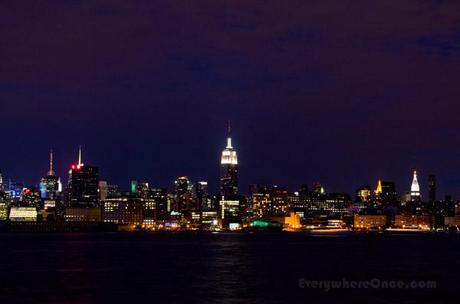
The downside of living someplace wonderful is that you take it for granted. Returning to New York after a long absence gave us a unique opportunity: to revisit all of our most familiar and favorite places and see them again as if for the first time. We couldn’t wait to dive back in.
Carmine’s Restaurant

New York has more restaurants than some cities have people: 20,000 of them. So many, in fact, it is possible to eat at a different establishment every single night for 55 years. Yet with all of those choices we only had one eatery on our minds, Carmine’s.
Our relationship with Carmine’s dates back almost to its beginnings in 1990. It’s been a love affair ever since. The oversized menus bolted to the walls haven’t changed in the twenty years we’ve known her. Neither has her incredible food, which is also served in oversized portions meant for sharing.
Arti Cutler designed Carmine’s so that each meal is like an Italian American wedding feast. He succeeded in making our every visit a celebration. We still prefer Carmine’s original Upper Westside Manhattan location but are glad to know the celebration has spread to D.C., Atlantic City, Los Vegas and Atlantis. When we can’t be in New York, we’ll be looking for her there.
Manhattan Nighttime Skyline
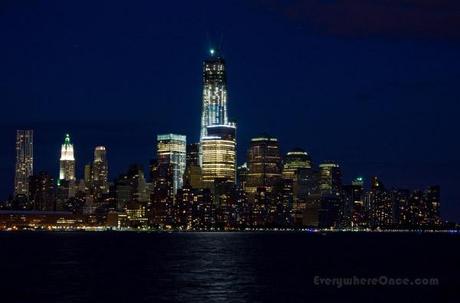
Lower Manhattan Skyline and “Freedom Tower”
The great irony of Manhattan is that its most beautiful feature is best seen by leaving the borough. We even leave the state. The above skyline photos were taken from Pier A Park in our beloved Hoboken, NJ. For purists who want to enjoy New York from within the city, equally good views can be had from Brooklyn and Queens.
Lower Manhattan
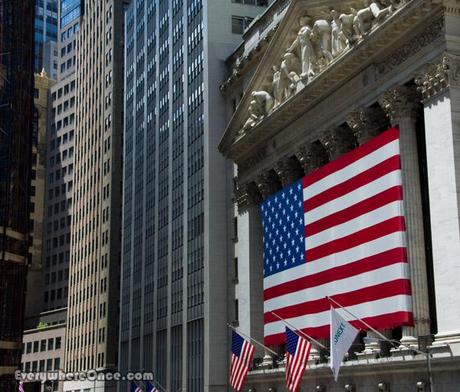
The New York Stock Exchange
If a city can be said to have a birthplace, New York’s is the tangled nest of narrow streets at the tip of Manhattan Island. Its proximity to one of the world’s largest natural harbors made downtown an early economic powerhouse, a title it never relinquished.
More than just the birth of a city, this area also ushered in the birth of a nation. Through Manhattan’s deep harbors flowed the country’s metaphorical lifeblood as well as the physical blood of our immigrant forefathers who powered U.S. growth for centuries. Fittingly, we inaugurated our first President at Wall Street’s Federal Hall, also the site of our nation’s first Capitol.
Set apart from the wide avenues and square blocks that characterize most of the rest of Manhattan, downtown – more than anywhere else – retains a sense of history. It’s a place where old and new live side by side. Stroll down the cobblestone laden Stone St. (first paved in 1658) as you make your way to Fraunces Tavern, where George Washington feasted after driving British soldiers from the city.
Stride, Master-of-the-Universe style, up the famous street named after a defensive “Wall” erected in 1653 toward Trinity Church and the final resting place of Alexander Hamilton. Admire the contrast between Trinity’s Gothic Revival architecture and the gleaming edifice of Freedom Tower, so new it is still growing toward its eventual 1,776 foot height. From there it’s a short jaunt toward the country’s oldest City Hall where you can take a well deserved breather in City Hall Park while gazing past the fountain and through the trees at the neo-gothic architecture of the world’s once tallest skyscraper, the Woolworth Building.
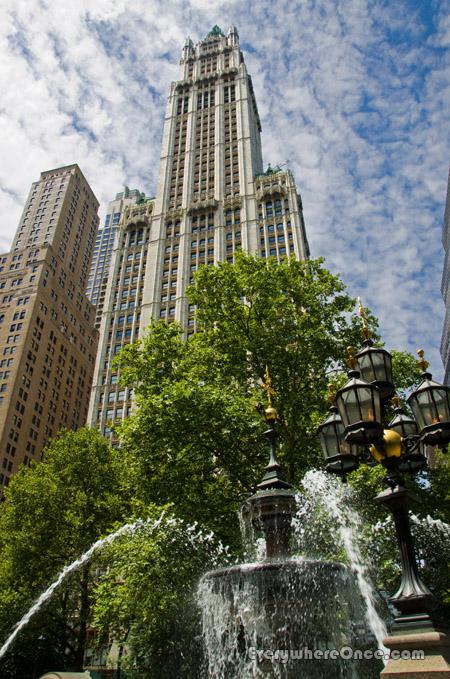
The Woolworth Building as seen from City Hall Park
Metropolitan Museum of Art
With more than 2 million items in its permanent collection, ranging from antiquities to modern art, the “Met” is exhaustingly large. It is not a place you can expect to conquer in an afternoon, or even in a week. For locals who can dip in repeatedly throughout the year the Met is one of Manhattan’s greatest treasures. It is by far our favorite U.S. museum. Tourists can make the most of their limited time here by following one or more of these official itineraries, complete with detailed map and audio guide (fee).
After a fulfilling afternoon of culture, simply step around the corner into the 800-acre oasis (known as Central Park) that borders the museum. Or hop the subway and use your museum ticket to gain access to the Medieval Cloisters.
Grand Central Terminal
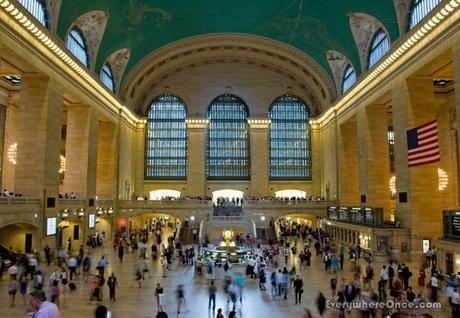
To resident New Yorkers this world’s largest train station is nearly invisible, just one of many such functional places that people traverse in the course of an ordinarily hectic day. But even the harried masses should spare a second to look around, and especially up, at this architectural masterpiece.
125 feet above the football field sized concourse is a ceiling mural depicting winter constellations in gold leaf and twinkling LED lights. Far more lovely today than when I first came to know it, a 1998 restoration project removed nearly a century’s accumulation of cigarette grime that had almost completely darkened Grand Central’s sky. Look above Michael Jordan’s Steakhouse for the small, unrestored, dark patch left as a reminder of how the entire ceiling once looked.
National September 11 Memorial
Just like any other weekday of the previous 18 years, I walked through the north exit of World Trade Center Tower 1 on my way to work. Only it wasn’t any other day. It was September 11, 2001, at approximately 6:40 A.M. Less than four hours later the building I commuted through was gone, taking far too many human lives with it.
For an agonizingly long while afterward the site remained a grievous gash; a hole in the ground like a wound that would not heal. By the time we left New York in April 2010, only the first few floors of the new “Freedom Tower” were visible above the construction fences. Slow, but healing, progress.
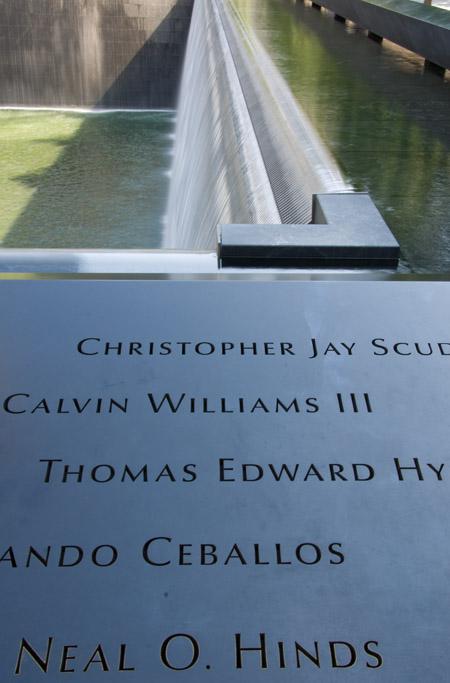
A decade and a day after the attacks, the National September 11 Memorial finally opened to the public on the grounds where the buildings once stood. The towers’ footprints, now represented by two acre-sized subterranean reflecting pools, are fed on all sides by cascades of water that try endlessly, and unsuccessfully, to fill the void. Above ground and bordering the rectangular waterfalls, bronze panels pay tribute to each of that day’s 2,977 victims and the six individuals murdered during the first World Trade Center bombing in 1993. Around the reflecting pools, more than 400 swamp white oak trees provide a buffer from the bustling city beyond.
With the area around the memorial still an active construction site, access is tightly controlled. In time those barriers will fall, construction will end, the now young white oaks will grow into a mighty grove, and the wound left open for so long will finally be healed. In time. Just not quite yet.
People Watching
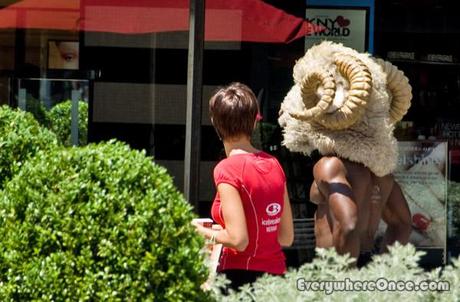
If there is one thing New Yorkers could learn from Europeans it is the practice of placing sidewalk café chairs theater style facing the street. Almost without exception, what’s happening on New York City sidewalks is more interesting than the person occupying the seat across from you. (Don’t feel bad, they’re thinking the same thing.) So skip the $200 Broadway admission and instead pull up a free seat to watch the daily spectacle of completely unrehearsed and totally spontaneous New York City street theater. You really can’t make this stuff up.

